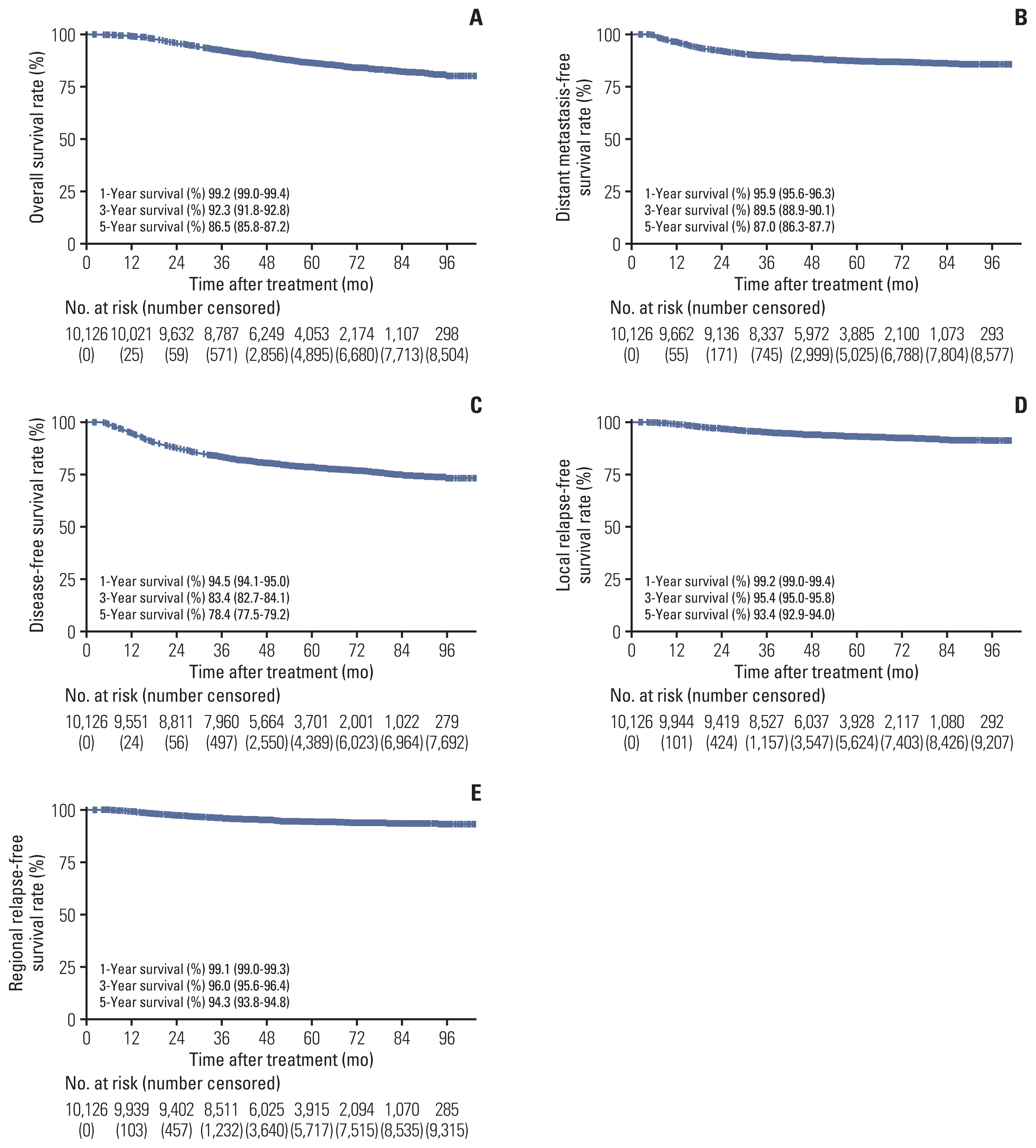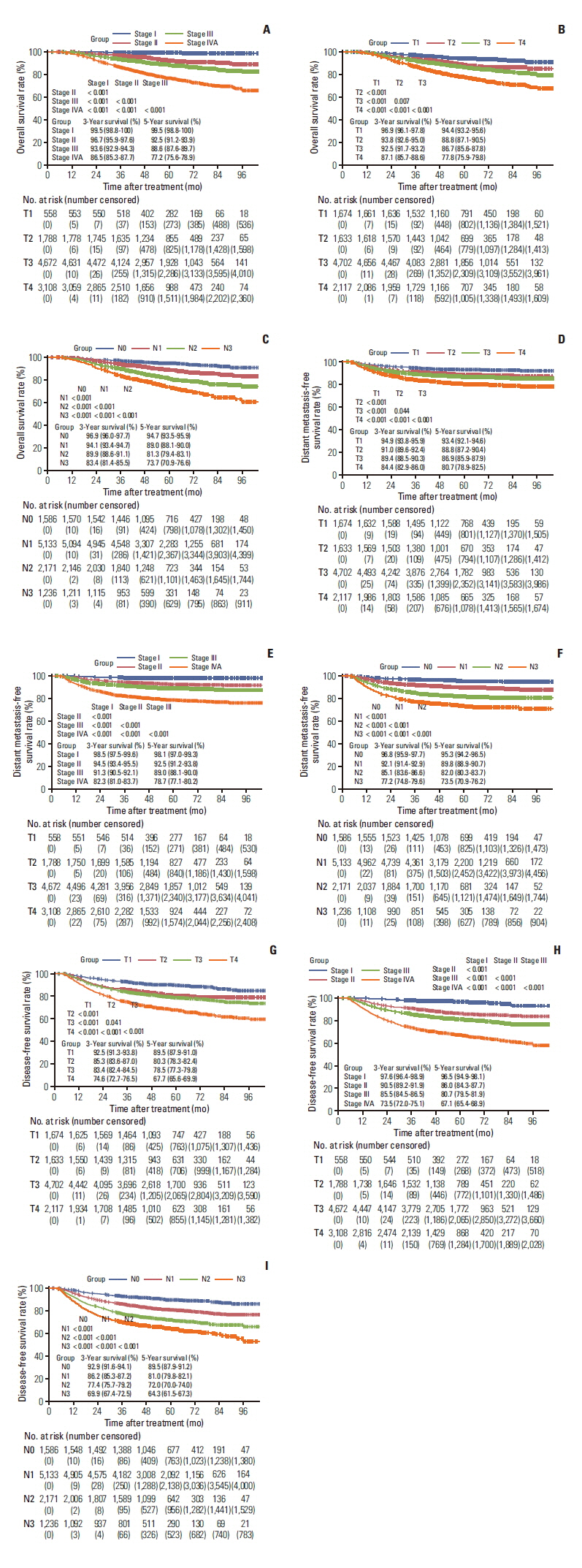Cancer Res Treat.
2021 Jul;53(3):657-670. 10.4143/crt.2020.899.
Development and Validation of Web-Based Nomograms to Precisely Predict Survival Outcomes of Non-metastatic Nasopharyngeal Carcinoma in an Endemic Area
- Affiliations
-
- 1Department of Radiation Oncology, Sun Yat-sen University Cancer Center, State Key Laboratory of Oncology in South China, Collaborative Innovation Center for Cancer Medicine, Guangdong Key Laboratory of Nasopharyngeal Carcinoma Diagnosis and Therapy, Guangzhou, China
- 2Department of Head and Neck Oncology, the Cancer Center of the Fifth Affiliated Hospital of Sun Yat-sen University, Zhuhai, China
- 3Department of Radiation Oncology, Wuzhou Red Cross Hospital, Wuzhou, China
- 4Department of Environmental Health Sciences, School of Public Health, University at Albany, State University of New York, Rensselaer, NY, USA
- KMID: 2518389
- DOI: http://doi.org/10.4143/crt.2020.899
Abstract
- Purpose
This study aimed to develop web-based nomograms to precisely predict survival outcomes in patients with non-metastatic nasopharyngeal carcinoma (NPC) in an endemic area.
Materials and Methods
A total of 10,126 patients who underwent radical intensity-modulated radiotherapy at Sun Yat-sen University Cancer Center (SYSUCC) from 2009 to 2015 were analyzed. We assigned patients into a training cohort (SYSUCC-A, n=6,751) and an internal validation cohort (SYSUCC-B, n=3,375) based on computer-generated random numbers. Patients collected from Wuzhou Red Cross Hospital (WZRCH) between 2012 and 2015 were used as the independent external validation cohort (WZRCH, n=450). Concordance index (C-index) was used to determine predictive accuracy and discriminative ability for the nomogram. The web-based clinicopathologic prediction models for predicting survival were based on Cox regression.
Results
The C-indexes for SYSUCC-A, SYSUCC-B, and WZRCH cohorts for the established nomograms to predict 3-year overall survival (OS) was 0.736, 0.715, and 0.691. Additionally, C-indexes to predict 3-year distant metastasis-free survival (DMFS) was 0.717, 0.706, and 0.686, disease-free survival (DFS) was 0.713, 0.697, and 0.656, local relapse-free survival was 0.695, 0.684, and 0.652, and regional relapse-free survival was 0.672, 0.650, and 0.616. The calibration plots showed great agreement between nomogram-predicted 3-year survival outcomes and actual 3-year survival outcomes. Moreover, C-indexes of the nomograms for OS, DMFS, and DFS were significantly superior than TNM stage (p< 0.001 for all).
Conclusion
These user-friendly nomograms can precisely predict survival endpoints in patients with non-metastatic NPC. They may serve as a useful tool for providing patient counseling and help physicians to make individual follow-up plans.
Keyword
Figure
Reference
-
References
1. Bray F, Ferlay J, Soerjomataram I, Siegel RL, Torre LA, Jemal A. Global cancer statistics 2018: GLOBOCAN estimates of incidence and mortality worldwide for 36 cancers in 185 countries. CA Cancer J Clin. 2018; 68:394–424.
Article2. Guo R, Tang LL, Mao YP, Du XJ, Chen L, Zhang ZC, et al. Proposed modifications and incorporation of plasma Epstein-Barr virus DNA improve the TNM staging system for Epstein-Barr virus-related nasopharyngeal carcinoma. Cancer. 2019; 125:79–89.
Article3. Tendulkar RD, Agrawal S, Gao T, Efstathiou JA, Pisansky TM, Michalski JM, et al. Contemporary update of a multi-institutional predictive nomogram for salvage radiotherapy after radical prostatectomy. J Clin Oncol. 2016; 34:3648–54.
Article4. Huang YQ, Liang CH, He L, Tian J, Liang CS, Chen X, et al. Development and validation of a radiomics nomogram for preoperative prediction of lymph node metastasis in colorectal cancer. J Clin Oncol. 2016; 34:2157–64.
Article5. Liang W, Zhang L, Jiang G, Wang Q, Liu L, Liu D, et al. Development and validation of a nomogram for predicting survival in patients with resected non-small-cell lung cancer. J Clin Oncol. 2015; 33:861–9.
Article6. Tang LQ, Li CF, Li J, Chen WH, Chen QY, Yuan LX, et al. Establishment and validation of prognostic nomograms for endemic nasopharyngeal carcinoma. J Natl Cancer Inst. 2016; 108:djv291.
Article7. Zhang LL, Li YY, Hu J, Zhou GQ, Chen L, Li WF, et al. Proposal of a pretreatment nomogram for predicting local recurrence after intensity-modulated radiation therapy in T4 nasopharyngeal carcinoma: a retrospective review of 415 Chinese patients. Cancer Res Treat. 2018; 50:1084–95.
Article8. Zeng Q, Hong MH, Shen LJ, Meng XQ, Guo X, Qian CN, et al. Nomograms for predicting long-term survival in patients with non-metastatic nasopharyngeal carcinoma in an endemic area. Oncotarget. 2016; 7:29708–19.
Article9. Huang XD, Zhou GQ, Lv JW, Zhou HQ, Zhong CW, Wu CF, et al. Competing risk nomograms for nasopharyngeal carcinoma in the intensity-modulated radiotherapy era: a big-data, intelligence platform-based analysis. Radiother Oncol. 2018; 129:389–95.
Article10. Jin YN, Zhang WJ, Cai XY, Li MS, Lawrence WR, Wang SY, et al. The characteristics and survival outcomes in patients aged 70 years and older with nasopharyngeal carcinoma in the intensity-modulated radiotherapy Era. Cancer Res Treat. 2019; 51:34–42.
Article11. Therneau T, Crowson C, Atkinson E. Using time dependent covariates and time dependent coefficients in the Cox model [Internet]. Vienna: R Foundation for Statistical Computing;2014. [cited 2020 Dec 4]. Available from: https://cran.r-project.org/web/packages/survival/vignettes/timedep.pdf .12. rms: Regression Modeling Strategies [Internet]. Vienna: R Foundation for Statistical Computing;2014. [cited 2020 Dec 4]. Available from: https://CRAN.R-project.org/package=rms .13. Package ‘compareC’ [Internet]. Vienna: R Foundation for Statistical Computing;2015. [cited 2020 Dec 4]. Available from: https://cran.r-project.org/web/packages/compareC/compareC.pdf .14. Mao YP, Tang LL, Chen L, Sun Y, Qi ZY, Zhou GQ, et al. Prognostic factors and failure patterns in non-metastatic nasopharyngeal carcinoma after intensity-modulated radiotherapy. Chin J Cancer. 2016; 35:103.
Article15. Tang LL, Chen YP, Mao YP, Wang ZX, Guo R, Chen L, et al. Validation of the 8th Edition of the UICC/AJCC staging system for nasopharyngeal carcinoma from endemic areas in the intensity-modulated radiotherapy era. J Natl Compr Canc Netw. 2017; 15:913–9.
Article16. Liang W, Shen G, Zhang Y, Chen G, Wu X, Li Y, et al. Development and validation of a nomogram for predicting the survival of patients with non-metastatic nasopharyngeal carcinoma after curative treatment. Chin J Cancer. 2016; 35:98.
Article17. Chen YP, Chan ATC, Le QT, Blanchard P, Sun Y, Ma J. Nasopharyngeal carcinoma. Lancet. 2019; 394:64–80.
Article18. Sun X, Su S, Chen C, Han F, Zhao C, Xiao W, et al. Long-term outcomes of intensity-modulated radiotherapy for 868 patients with nasopharyngeal carcinoma: an analysis of survival and treatment toxicities. Radiother Oncol. 2014; 110:398–403.
Article19. Lai SZ, Li WF, Chen L, Luo W, Chen YY, Liu LZ, et al. How does intensity-modulated radiotherapy versus conventional two-dimensional radiotherapy influence the treatment results in nasopharyngeal carcinoma patients? Int J Radiat Oncol Biol Phys. 2011; 80:661–8.20. Wu LR, Liu YT, Jiang N, Fan YX, Wen J, Huang SF, et al. Ten-year survival outcomes for patients with nasopharyngeal carcinoma receiving intensity-modulated radiotherapy: an analysis of 614 patients from a single center. Oral Oncol. 2017; 69:26–32.
Article21. Yao JJ, Jin YN, Liu ZG, Liu QD, Pei XF, Zhou HL, et al. Do all patients with advanced N-stage nasopharyngeal carcinoma benefit from the addition of induction chemotherapy to concurrent chemoradiotherapy? Ther Adv Med Oncol. 2019; 11:1758835919833863.
Article22. Chua DT, Ma J, Sham JS, Mai HQ, Choy DT, Hong MH, et al. Long-term survival after cisplatin-based induction chemotherapy and radiotherapy for nasopharyngeal carcinoma: a pooled data analysis of two phase III trials. J Clin Oncol. 2005; 23:1118–24.
Article23. Chang H, Peng L, Tao YL, Chen C, Xiao WW, Hu YH, et al. Necessity of concurrent chemotherapy in N2–3 nasopharyngeal carcinoma treated with neoadjuvant chemotherapy of ≥ 3 cycles followed by intensity-modulated radiotherapy. Cancer Med. 2019; 8:2823–31.24. Zhang MX, Li J, Shen GP, Zou X, Xu JJ, Jiang R, et al. Intensity-modulated radiotherapy prolongs the survival of patients with nasopharyngeal carcinoma compared with conventional two-dimensional radiotherapy: A 10-year experience with a large cohort and long follow-up. Eur J Cancer. 2015; 51:2587–95.
Article25. Lee AW, Fee WE Jr, Ng WT, Chan LK. Nasopharyngeal carcinoma: salvage of local recurrence. Oral Oncol. 2012; 48:768–74.
Article26. Zhang B, Tian J, Dong D, Gu D, Dong Y, Zhang L, et al. Radiomics features of multiparametric MRI as novel prognostic factors in advanced nasopharyngeal carcinoma. Clin Cancer Res. 2017; 23:4259–69.
Article27. Gu B, Zhang J, Ma G, Song S, Shi L, Zhang Y, et al. Establishment and validation of a nomogram with intratumoral heterogeneity derived from (18)F-FDG PET/CT for predicting individual conditional risk of 5-year recurrence before initial treatment of nasopharyngeal carcinoma. BMC Cancer. 2020; 20:37.
Article28. Peng G, Wang T, Yang KY, Zhang S, Zhang T, Li Q, et al. A prospective, randomized study comparing outcomes and toxicities of intensity-modulated radiotherapy vs. conventional two-dimensional radiotherapy for the treatment of nasopharyngeal carcinoma. Radiother Oncol. 2012; 104:286–93.
Article29. Au KH, Ngan RK, Ng AW, Poon DM, Ng WT, Yuen KT, et al. Treatment outcomes of nasopharyngeal carcinoma in modern era after intensity modulated radiotherapy (IMRT) in Hong Kong: a report of 3328 patients (HKNPCSG 1301 study). Oral Oncol. 2018; 77:16–21.
Article30. Sun Y, Tang LL, Chen L, Li WF, Mao YP, Liu LZ, et al. Promising treatment outcomes of intensity-modulated radiation therapy for nasopharyngeal carcinoma patients with N0 disease according to the seventh edition of the AJCC staging system. BMC Cancer. 2012; 12:68.
Article31. Cho WK, Oh D, Lee E, Kim TG, Lee H, Nam H, et al. Feasibility of selective neck irradiation with lower elective radiation dose in treating nasopharynx cancer patients. Cancer Res Treat. 2019; 51:603–10.
Article32. Jin YN, Yao JJ, Zhang F, Wang SY, Zhang WJ, Zhou GQ, et al. Is pretreatment Epstein-Barr virus DNA still associated with 6-year survival outcomes in locoregionally advanced nasopharyngeal carcinoma? J Cancer. 2017; 8:976–82.
Article
- Full Text Links
- Actions
-
Cited
- CITED
-
- Close
- Share
- Similar articles
-
- Development and Validation of Web-Based Nomograms to Predict Postoperative Invasive Component in Ductal Carcinoma in Situ at Needle Breast Biopsy
- Nomograms to Predict the Individual Survival of Patients with Solitary Hepatocellular Carcinoma after Hepatectomy
- Development of Web-Based Nomograms to Predict Treatment Response and Prognosis of Epithelial Ovarian Cancer
- Establishment and Validation of a Nomogram for Nasopharyngeal Carcinoma Patients Concerning the Prognostic Effect of Parotid Lymph Node Metastases
- Nomogram to Predict Treatment Outcome of Fluoropyrimidine/Platinum-Based Chemotherapy in Metastatic Esophageal Squamous Cell Carcinoma




